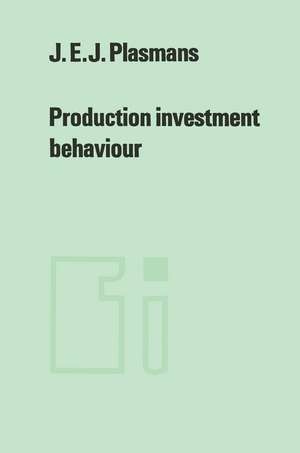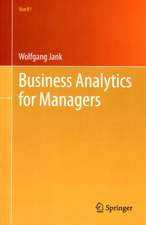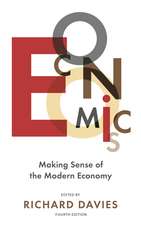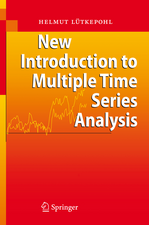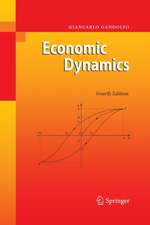Production investment behaviour: Application to six EEC-countries: Tilburg Studies in Economics, cartea 12
Autor J.E.J. Plasmansen Limba Engleză Paperback – 22 apr 2012
Din seria Tilburg Studies in Economics
-
 Preț: 375.45 lei
Preț: 375.45 lei -
 Preț: 384.86 lei
Preț: 384.86 lei -
 Preț: 378.92 lei
Preț: 378.92 lei -
 Preț: 389.11 lei
Preț: 389.11 lei -
 Preț: 382.57 lei
Preț: 382.57 lei -
 Preț: 386.22 lei
Preț: 386.22 lei -
 Preț: 386.00 lei
Preț: 386.00 lei -
 Preț: 385.25 lei
Preț: 385.25 lei - 18%
 Preț: 950.96 lei
Preț: 950.96 lei -
 Preț: 384.31 lei
Preț: 384.31 lei -
 Preț: 381.21 lei
Preț: 381.21 lei -
 Preț: 381.81 lei
Preț: 381.81 lei -
 Preț: 376.59 lei
Preț: 376.59 lei -
 Preț: 377.18 lei
Preț: 377.18 lei -
 Preț: 382.36 lei
Preț: 382.36 lei -
 Preț: 381.43 lei
Preț: 381.43 lei
Preț: 390.63 lei
Nou
Puncte Express: 586
Preț estimativ în valută:
74.76€ • 77.45$ • 62.39£
74.76€ • 77.45$ • 62.39£
Carte tipărită la comandă
Livrare economică 21 martie-04 aprilie
Preluare comenzi: 021 569.72.76
Specificații
ISBN-13: 9789401178273
ISBN-10: 9401178275
Pagini: 356
Ilustrații: 350 p.
Dimensiuni: 152 x 229 x 19 mm
Greutate: 0.48 kg
Ediția:Softcover reprint of the original 1st ed. 1975
Editura: SPRINGER NETHERLANDS
Colecția Springer
Seria Tilburg Studies in Economics
Locul publicării:Dordrecht, Netherlands
ISBN-10: 9401178275
Pagini: 356
Ilustrații: 350 p.
Dimensiuni: 152 x 229 x 19 mm
Greutate: 0.48 kg
Ediția:Softcover reprint of the original 1st ed. 1975
Editura: SPRINGER NETHERLANDS
Colecția Springer
Seria Tilburg Studies in Economics
Locul publicării:Dordrecht, Netherlands
Public țintă
ResearchCuprins
1. Some remarks on the concept of a production function.- 1.1 The Production Function.- 1.2 The Input (Level) Set.- 1.3 The Relationship between Production Functions and Input (Level) Sets.- 1.4 Transforms of Production Functions.- 1.5 Homogeneous and homothetic Production Functions.- 1.6 Substitutability in neoclassical Production Functions.- 1.7 Some particular neoclassical Production Functions.- 1.8 Technical Progress in neoclassical and vintage Production Functions.- 1.9 Conclusion.- 2. Investment behaviour based on micro production models.- 2.0 Introduction.- 2.1 A putty-putty ces-Investment Model.- 2.2 A putty-clay ces-Investment Model.- 2.3 A non-vintage ces-Investment Model.- 2.4 A putty-putty ves-Investment Model.- 2.5 A putty-clay ves-Investment Model.- 2.6 A non-vintage ves-Investment Model.- 2.7 An Adjustment Cost Model for the Investment Demand.- 2.8 Conclusion.- 3. The aggregation problem: the utilization of micro-relationships for macro-data.- 3.1 Functional Separability.- 3.2 Deterministic Aggregation.- 3.3 Bias in Deterministic Aggregation.- 3.4 Stochastic Aggregation.- 3.5 Conclusion.- 4. An application on postwar investment behaviour of six eec-countries.- 4.0 Introduction.- 4.1 Belgium.- 4.2 France.- 4.3 Germany (Federal Republic).- 4.4 Great Britain (inclusive Northern Ireland).- 4.5 Italy.- 4.6 Netherlands.- 4.7 Conclusion.- A.1 Derivation of the Class of CES-Production Functions.- Appendix B. Necessary conditions for the supremum of the functional (II.1.6).- Appendix C. Optimal control problems with an infinite time horizon.- Appendix D. The investment relationships discussed.- List of Symbols.
